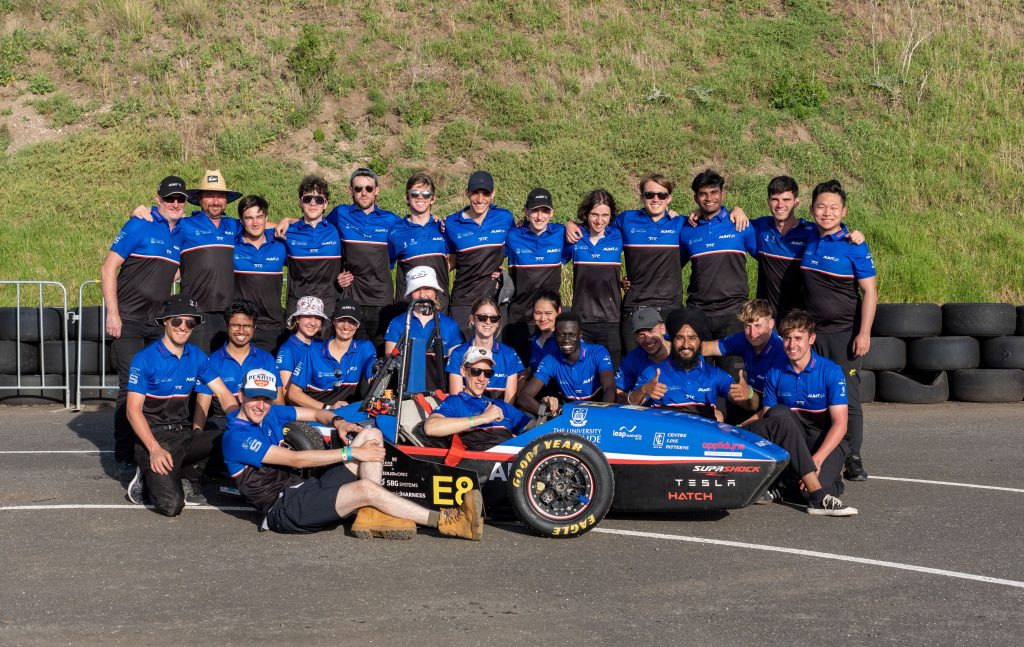Adelaide University Motorsport Team combines global racing opportunities with curious young engineers to cultivate skills that are the cornerstone of electrical vehicle engineering.
Founded in 2001, Adelaide University Motorsport Team (AUMT) combines cross-disciplinary knowledge to design, manufacture and promote a vehicle to compete in the annual Formula-SAE Australasia competition (FSAE-A).
The project takes students out of lecture halls and onto racetracks where they can apply theoretical knowledge; gain hands-on experience in business, project and team management; and have exposure to various engineering disciplines.
Making the switch
In 2018, AUMT moved away from traditional routes and switched to electric power for its race vehicles, competing in the electric vehicle category of FSAE-A.
Jacob Ditter, Chief Engineer at AUMT, explained the motive behind this transition.
“Students were showing an interest in making the change; there’s a lot more potential in electric vehicles (EVs), so it was predominantly a performance-driven decision,” Ditter told create.
“Many of our sponsors have a big focus on sustainability and looking towards the future, so that was also a major influencer,” Dev Patel, AUMT’s Business Manager, added.
Amid the ever-growing impact of climate change, Ditter touched on the importance of incorporating sustainability into vehicle production.
“We’re thinking about the future and pushing forward towards more sustainable methods,” he said.
Pooling skills
Another major driver, according to Team Leader Jake Herrmann, was the need to diversify the group of students included in the project.
“We realised that the team was heavily composed of mechanical engineers and there was a gap that needed filling,” he explained. “We wanted electrical engineers to get involved with learning hands-on skills, especially [here] in South Australia.”

In 2022, engineering vacancies in the state increased by 23 per cent, with a particular rise in vacancies for electrical engineers.
This figure didn’t go unnoticed by AUMT, which has prioritised a diverse intake of students to pool the necessary skills across mechanical and electrical engineering, computer science and business.
“The aim is to upskill engineers early on so when they go into industry they are building on systems that we have already had in place,” said Herrmann.
Patel emphasised the efforts made to expand on the collective skillset.
“This year we extended our branch into other faculties, and now we have more business and finance students on the team to help grow the business.”
From design to race track
For most students entering AUMT, working hands-on to manufacture an EV from the ground up is uncharted territory, with the project offering a unique opportunity to gain industry experience.
“It’s a good way to make mistakes early on and learn how to fix them without detrimental consequences,” Herrmann said.
The team has established a series of procedures to guide students through the process, from ideation to competition.
“We have a [detailed] management structure … which we use to micromanage a global team,” he said. “After each competition, we sit down and analyse the process to pinpoint key challenges and wins to improve the different systems in place.
“The design, manufacturing, assembling, testing [and] racing process is completed through four different engineering subsystems: electrics, vehicle dynamics, structure and aerodynamics. All four systems collaborate to make the design changes.”
Zooming ahead
After winning first place in the 2023 Electric Vehicle Endurance Event at Formula SAE-A, the team reflected on what it was that got them there.
“There’s a lot of testing and troubleshooting that goes into event preparation,” Herrmann explained. “We revamped the accumulator with a system we were unfamiliar with, so knowing why things were happening was vital.
“The big change from our 2022 and 2023 competition vehicles was the accumulators. The 2022 vehicle had two side pod batteries but in 2023, we moved to a single accumulator situated behind the driver.”
Beyond the finish line
Students leave AUMT with a diverse skill set, propelling them into exciting roles.
“One of our team members from 2023 has just moved over to the UK to work with Mercedes F1,” Ditter said.
“I’ve made valuable industry connections and learnt critical skills that employers are looking for, beyond [the] university lecture halls.”
